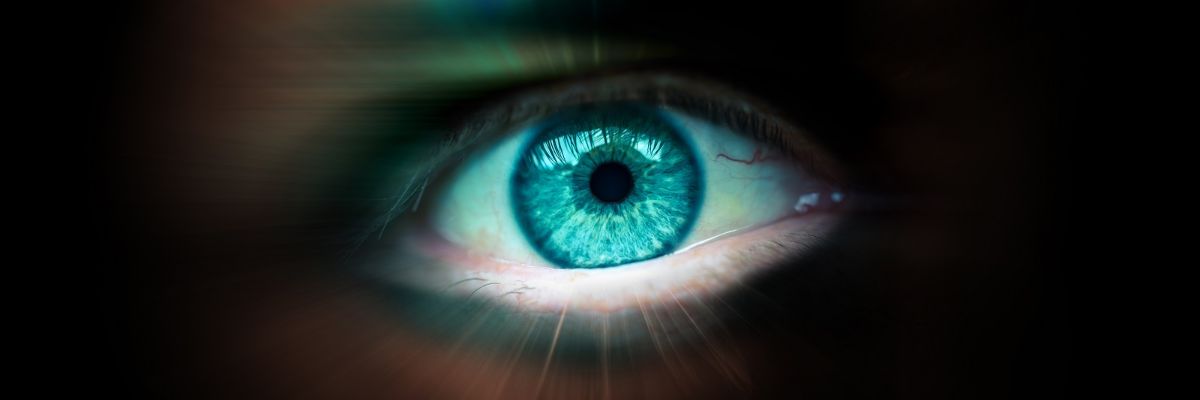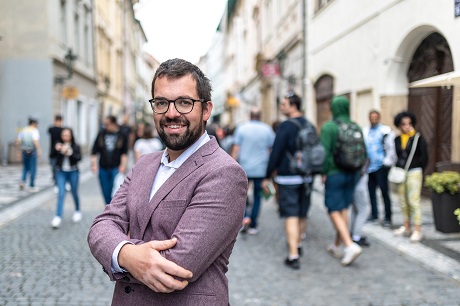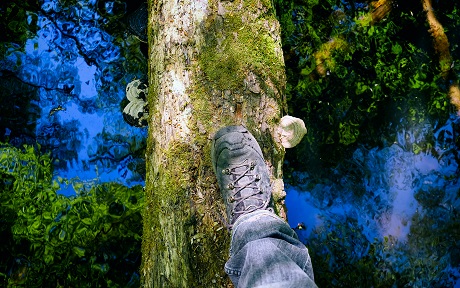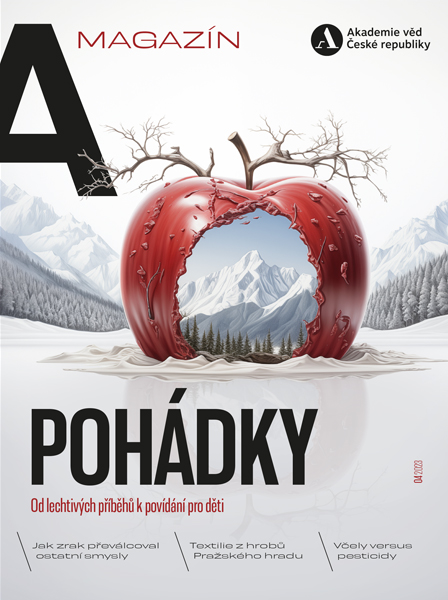
From an evolutionary POV, vision has a great benefit–cost ratio, researcher says
09. 04. 2024
We use our eyes to acquire over 80 percent of all information from our surroundings. Why is it sight that has prevailed over our other senses? How come we don’t go crazy from the influx of visual stimuli? And what actually sticks? Filip Děchtěrenko from the Institute of Psychology of the Czech Academy of Sciences (CAS), whose focus is visual perception, attention, and memory, knows the answers. An article about his research was published in the quarterly CAS A / Magazine.
The eye is smaller than a ping pong ball and weighs about as much as a Reese’s peanut butter cup. And yet, right after the brain, it is the second most intricate organ found in the human body. What’s more, it often reveals more about its owner than they might want. A mere glance can not only reveal what a person is experiencing at the moment, but also what they are actually thinking about.
“We can deduce what somebody is concentrating on from what they are looking at. That’s because in most ordinary situations, eye movements are closely linked to attention,” says Filip Děchtěrenko from the Institute of Psychology of the Czech Academy of Sciences (CAS), whose research focus is visual perception, attention, and memory.

Filip Děchtěrenko from the Institute of Psychology of the CAS. (CC)
According to him, the saying “The eyes are the window to the soul” holds true to a surprising degree. And it is anatomically accurate, too. “Nerve cells are located directly on the surface of the retina. So when you gaze into someone’s eyes, with a bit of exaggeration, you’re also glimpsing a piece of their brain,” the psychologist and computer scientist explains with a smile.
Peekaboo
Two hundred milliseconds. That’s all the time our eyes need to orient themselves in space. But they only need a tenth of a second to recognise what’s in a picture. In this brief instance, our attention is usually drawn to something that stands out from the rest – whether it’s colour, the orientation of edges, or the intensity or contrast of light. Simply put, it captures our attention – otherwise known as salience.
“When you see ten men in black suits and one in red, you’ll almost certainly focus on the unique one first. We call this a bottom–up approach to information processing – and it’s something we do unwittingly,” the researcher explains.
However, zeroing in on the visually most interesting object lasts literally a mere moment. Then, our attention is taken over by so-called top–down processing – we realize what our goal is and we become aware of our task. We then direct our gaze and attention accordingly. A spy, for instance, would start using their eyes to search for an access card or keys, while a child craving entertainment would seek out toys or crayons.
“Our resulting attention is thus a mix of these two processes. But we also need to consider our natural inclination to look at the centre of things,” Děchtěrenko points out.
That’s because the yellow spot at the centre of the retina (the back of the eye) – i.e., the depression called the fovea centralis – consists of the most light-sensitive cells, which means our vision is sharpest at that point. Therefore, it’s tactical to position the eye so that the visual stimulus in question is directly in the line of sight of the fovea.
Our eyes routinely flit from one place to another in an attempt to achieve this ideal position and bring the stimulus to the centre of our sharpest vision. These jumps from one point of fixation to another are called saccades, and they take the eyes a lot of work – these are actually the fastest movements the human body is capable of (lasting 10–100 milliseconds). We do them practically all the time.
“What’s interesting is that during saccades, we don’t process visual information. We wait for fixation to do that. That’s why, the instance we shift our eyes, we’re essentially blind,” the scientist explains. “For instance, if a gorilla were to suddenly appear here just as you shifted your gaze from the bookshelf to the chair, you wouldn’t notice it,” he laughs.
However, these moments of “blindness” are so brief that we don’t even have time to realize them. Our cunning brain is capable of rapidly filling in these gaps, so it all merges in our mind into one coherent perception.

Our eyes are capable of orienting themselves in space in a mere 200 milliseconds.
An ocean you don’t drown in
They’re like an avalanche. From all sides, we are almost constantly assaulted by a mass of visual stimuli. And it’s thanks to attention that we don’t go crazy in the barrage of information. Attention acts as a filter, allowing only a limited amount of data into our consciousness.
“We can imagine the omnipresent stimuli as an ocean that surrounds us. But it flows directly to us through a pipe that can only hold a certain amount of water. And that’s why we don’t drown in it,” the researcher explains.
It sounds fairly simple. However, the reality is understandably much more complicated. It takes about a million neurons alone just to transform a visual stimulus into a perception!
And what does this journey look like in a nutshell? First, the visual data reaches the retina, where it is encoded into an electrical signal. This signal then travels through the optic nerve to the visual centre at the back of the cerebral cortex in the occipital lobe, where it is subsequently processed. All of this happens in mere milliseconds.
“From an evolutionary point of view, vision has an excellent benefit–cost ratio. We can use vision to quickly gather a lot of information, significantly increasing our chances of survival. It’s no wonder it became our dominant sense,” Děchtěrenko notes.
In other words: if an animal were approaching us, for instance, we’d be able to tell by a single glance whether it poses a danger to us, how quickly it moves, what frame of mind it’s in, or how far away it is from us.
Fun fact: we owe our ability to estimate distance and depth to having two eyes. Each eye captures the world from a slightly different angle. Our brain then combines information from both eyes, and spatial vision is born!
It’s worth mentioning that what we excel at is monitoring everything below us. “We have better angular resolution capabilities when we look down than when we look up. This, too, can be attributed to evolution: the likelihood of something killing us from below was much higher, so we developed this skill to a more advanced degree,” the researcher points out.
Face to face
“I just don’t have a good memory for faces.” This sentence often comes in handy when we happen to accidentally blank someone we know on the street. However, in the vast majority of cases, this is merely an excuse. In reality, people excel at recognizing faces.
Unless, of course, they belong to the roughly two percent of the population suffering from a rare condition called prosopagnosia, aka face blindness, which is caused by damage to a tiny fold in the temporal lobe of the brain called the fusiform gyrus. That’s where we can find an area specially dedicated to face recognition.

For evolutionary reasons, humans excel at facial recognition.
“From an evolutionary standpoint, this skill has always been crucial for humans. It was useful to be able to distinguish whether the other person in our vicinity is our relative, likes us, or is angry with us. Being so skilled at recognizing and distinguishing types of rocks, for instance, certainly wouldn’t have brought us as much advantage or utility,” Děchtěrenko speculates.
However, our ability to discern faces has its limits, which we might stumble upon when faced, for example, with a different race. But why do Asians, for instance, all look the same to Europeans and vice versa? The answer is simple: we have developed a greater sensitivity to distinguishing the races with which we have been surrounded since birth. We’ve learned to recognise details within the community we belong to. Thus, a child raised by Chinese parents in China gradually becomes an expert on Asian faces, while a toddler growing up in Austria soon becomes proficient in discerning European features.
“However, we’re all equally bad at face recognition when encountering a face upside down. We simply can’t remember a face seen upside down, nor can we accurately read emotions from it. Our brain isn’t accustomed to this and simply doesn’t know how to cope with it,” the psychologist adds.
Four is the magic number
Eight grey balls roll across the computer screen every which way. After a moment, four of them turn green, briefly, before changing back to grey and continuing their wild dance. The person looking at the screen is supposed to remember which balls underwent the colour change.
Tasks like this one help researchers uncover the mechanisms of so-called divided attention – our ability to monitor multiple things simultaneously.
“It turns out that we can monitor four out of eight balls relatively well; we can do so automatically. However, if we have to observe more objects, our ability to track them decreases dramatically,” Děchtěrenko explains. According to him, in human psychology, the number four often appears as one of those magical limits. “Imagine, for instance, that you have to watch over kids swimming in a pond. If there are just four of them, you don’t even have to count them – you’re simply able to keep an eye on them. But if there are more than four, you’ll start counting whether you like it or not. This is one of those things that’s good to know before heading out with a larger group of kids,” the father of three and experienced scout leader says with a grin.
“Unlike identically coloured balls, we can usually distinguish children from each other, which significantly facilitates their monitoring. That’s why a kindergarten teacher is able to keep an eye on their whole class,” the researcher adds.
It was precisely the task with the coloured balls that, years ago, during his studies of theoretical computer science, led Děchtěrenko to pursue psychology. He came across it during a seminar on integrating information technologies into the study of human cognition. The topic fascinated him to such a degree that he applied for psychology, and Jiří Lukavský, the creator of the mentioned course, soon became his supervisor. Today, they are research colleagues, and psychology and computer science are harmoniously integrated in their work.
A flood of photos
Sunsets in romantic bays, obligatory beach selfies, ancient churches overgrown with hibiscus, lavish breakfasts, even more lavish dinners... Most people can’t resist the urge to flood their surroundings with photos upon returning from vacation. But what does the observer actually take away from this avalanche of snapshots?

Filip Děchtěrenko is researching how well we remember photos.
Our memory retention for photos is (along with eye movements and divided attention) one of Děchtěrenko’s research topics – and artificial neural networks are his faithful assistants in this endeavour.
“We work with tools of machine learning, where a computer program is trained to perform a certain task. The creators of these neural networks were inspired by the functioning of the human brain and created artificial neurons that communicate with each other and exchange information just like human neurons. And you can teach them almost anything,” the researcher explains.
However, neural networks are nothing new. For several years now, they have been commonly used, for instance, in machine translation engines, image recognition software, medical diagnostics, or even for predicting stock market trends.
“We utilise neural networks to create artificial photos for our experiments. Thanks to them, we have at our disposal numerical evaluations for each image. In other words, besides the image, the network generates a set of four thousand numbers comprising what it ‘thinks’ of that particular photo. Based on this set, we are then able to design very accurate memory experiments,” Děchtěrenko says.
In their latest research endeavour, his team was interested in how much detail we can retain in our minds regarding the content of a photo. In the past, two studies with contradictory conclusions had been published on this topic, and researchers from the Institute of Psychology of the CAS wanted to determine which one was correct.
A study from 1973 claimed that people could remember 93% of ten thousand photos. However, they were only able to retain a very rough idea of what the photos depicted. Thirty-five years later, a different group of researchers published a study suggesting that even when viewing six thousand photos, our memory stays very detailed.
“However, our experiments indicate that retention is more general. Even if you motivate someone with money to remember as many details about an image as possible, they’re still not capable of doing so," the scientist notes.
First and last
The preparations of such an experiment can take up to a whole year. The photos must be selected and modified with absolute precision. Then, it’s necessary to write code for the experiment and gather a sufficient number of participants – usually around fifty. The test subjects then sit at computers and receive their instructions. For instance, as in the aforementioned case: “Memorise as much as you can about the following photos; you have three minutes per photo.”
When the test subjects click through the series of images to the end, their memory then needs to be tested. While the participants are breaking into a cold sweat in front of their computer screens, the researchers still have the main chunk of work ahead of them. “Analysing the acquired data is my favourite part. We calculate models, test our hypotheses... Throughout the experiment, computer science tools are integrated and used in tandem with psychological ones,” Děchtěrenko points out.

We have better angular resolution capabilities when we look down than when we look up.
With the help of the results of his research, the young psychologist aims to uncover techniques that would enable people to memorise visual information as effectively as possible. Med students could then more easily memorise, for instance, individual folds of intestinal loops or the internal arrangement of organs as sketched in anatomical atlases.
Such a manual may still be a bit of a sci-fi concept, however, some mechanisms of visual memory have already been discovered by scientists, and it can be helpful to know them. “It is known, for example, that we always retain the first and last things we memorise the best. Whether these be words in a list, people’s names during mass introductions, or even photos. There’s a grey area in between. Therefore, you better believe that the intro of this article and this last paragraph will likely stick with you the longest,” the researcher concludes with a smile.
Mgr. et Mgr. FILIP DĚCHTĚRENKO, Ph.D.
Institute of Psychology of the CAS
Děchtěrenko studied psychology at the Faculty of Arts and theoretical informatics at the Faculty of Mathematics and Physics at Charles University in Prague, where he also earned his PhD degree. Since 2011, he has been working at the Institute of Psychology of the CAS. He also teaches at the Department of Psychology at the Faculty of Arts, Charles University in Prague. In 2019, he received the Otto Wichterle Award for outstanding young scientists. He focuses primarily on research in visual perception, attention, and memory.
The full article (in Czech) can be found in the quarterly A / Magazine, published by the Czech Academy of Sciences.

4/2023 (version for browsing)
4/2023 (version for download)
---
Prepared by: Radka Římanová, External Relations Division, CAO of the CAS
Translated by: Tereza Novická, External Relations Division, CAO of the CAS
Photo: Shutterstock, Jana Plavec, External Relations Division, CAO of the CAS
 The text and photos labelled CC are released for use under the Creative Commons licence.
The text and photos labelled CC are released for use under the Creative Commons licence.
Read also
- A trapped state: The pandemic impact on public attitudes, trust, and behavior
- Aerial archaeology: Tracing the footsteps of our ancestors from the sky
- Archaeologists uncover ancient finds along Prague Ring Road
- Our microbiome largely depends on what we eat, says microbiologist Michal Kraus
- The ABCs of writing: Why did its invention mark a turning point for humankind?
- We learn, remember, forget… What can memory actually do? And can we outsmart it?
- New Center for Electron Microscopy in Brno opens its doors to global science
- The hidden lives of waste: What can we learn from waste workers and pickers?
- A unique lab is hidden right beneath Prague’s Vítkov Hill
- Renewables are a strategic investment in European security, scientists say
The Czech Academy of Sciences (the CAS)
The mission of the CAS
The primary mission of the CAS is to conduct research in a broad spectrum of natural, technical and social sciences as well as humanities. This research aims to advance progress of scientific knowledge at the international level, considering, however, the specific needs of the Czech society and the national culture.
President of the CAS
Prof. Eva Zažímalová has started her second term of office in May 2021. She is a respected scientist, and a Professor of Plant Anatomy and Physiology.
She is also a part of GCSA of the EU.